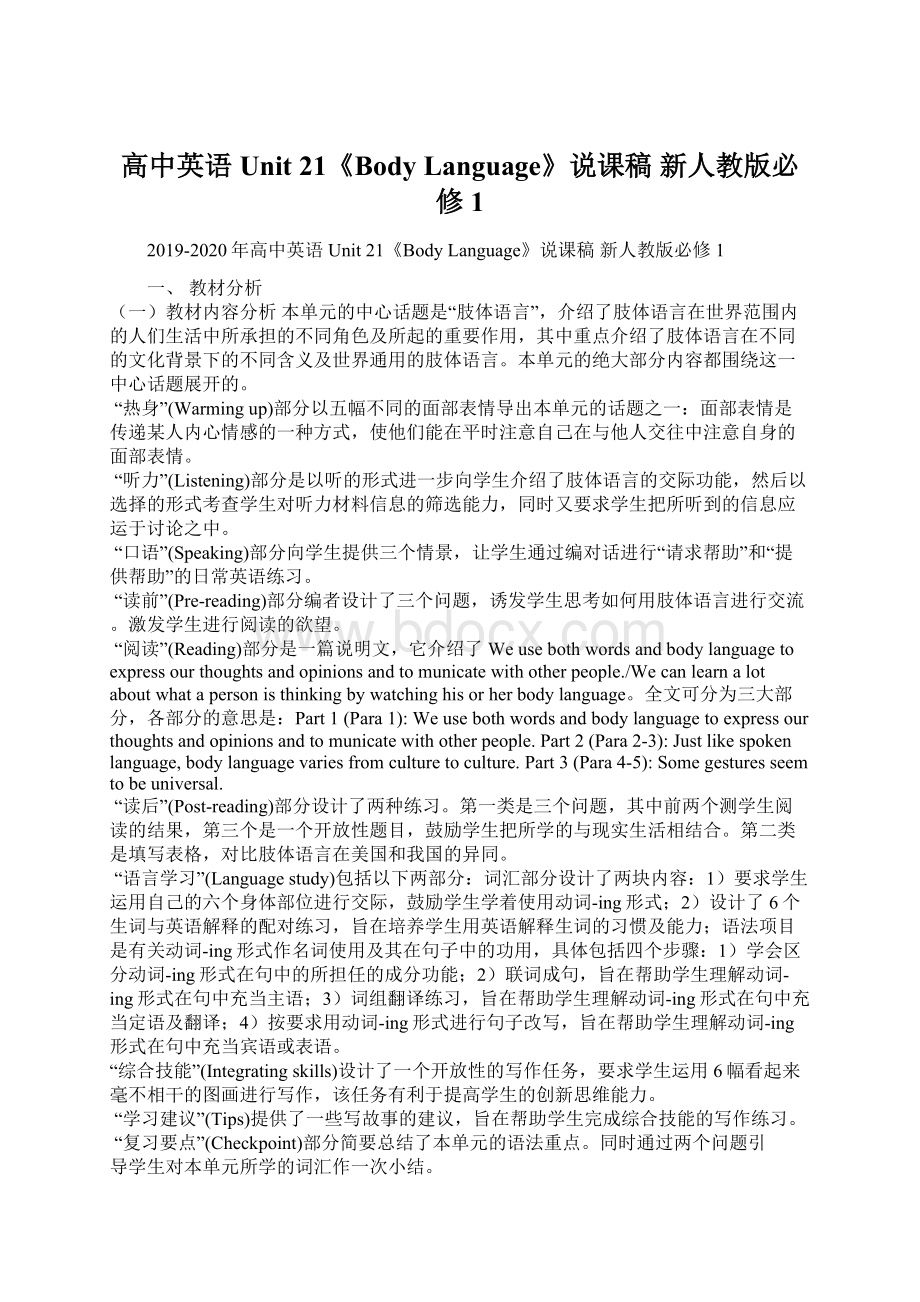高中英语 Unit 21《Body Language》说课稿 新人教版必修1.docx
《高中英语 Unit 21《Body Language》说课稿 新人教版必修1.docx》由会员分享,可在线阅读,更多相关《高中英语 Unit 21《Body Language》说课稿 新人教版必修1.docx(9页珍藏版)》请在冰豆网上搜索。

高中英语Unit21《BodyLanguage》说课稿新人教版必修1
2019-2020年高中英语Unit21《BodyLanguage》说课稿新人教版必修1
一、教材分析
(一)教材内容分析本单元的中心话题是“肢体语言”,介绍了肢体语言在世界范围内的人们生活中所承担的不同角色及所起的重要作用,其中重点介绍了肢体语言在不同的文化背景下的不同含义及世界通用的肢体语言。
本单元的绝大部分内容都围绕这一中心话题展开的。
“热身”(Warmingup)部分以五幅不同的面部表情导出本单元的话题之一:
面部表情是传递某人内心情感的一种方式,使他们能在平时注意自己在与他人交往中注意自身的面部表情。
“听力”(Listening)部分是以听的形式进一步向学生介绍了肢体语言的交际功能,然后以选择的形式考查学生对听力材料信息的筛选能力,同时又要求学生把所听到的信息应运于讨论之中。
“口语”(Speaking)部分向学生提供三个情景,让学生通过编对话进行“请求帮助”和“提供帮助”的日常英语练习。
“读前”(Pre-reading)部分编者设计了三个问题,诱发学生思考如何用肢体语言进行交流。
激发学生进行阅读的欲望。
“阅读”(Reading)部分是一篇说明文,它介绍了Weusebothwordsandbodylanguagetoexpressourthoughtsandopinionsandtomunicatewithotherpeople./Wecanlearnalotaboutwhatapersonisthinkingbywatchinghisorherbodylanguage。
全文可分为三大部分,各部分的意思是:
Part1(Para1):
Weusebothwordsandbodylanguagetoexpressourthoughtsandopinionsandtomunicatewithotherpeople.Part2(Para2-3):
Justlikespokenlanguage,bodylanguagevariesfromculturetoculture.Part3(Para4-5):
Somegesturesseemtobeuniversal.
“读后”(Post-reading)部分设计了两种练习。
第一类是三个问题,其中前两个测学生阅读的结果,第三个是一个开放性题目,鼓励学生把所学的与现实生活相结合。
第二类是填写表格,对比肢体语言在美国和我国的异同。
“语言学习”(Languagestudy)包括以下两部分:
词汇部分设计了两块内容:
1)要求学生运用自己的六个身体部位进行交际,鼓励学生学着使用动词-ing形式;2)设计了6个生词与英语解释的配对练习,旨在培养学生用英语解释生词的习惯及能力;语法项目是有关动词-ing形式作名词使用及其在句子中的功用,具体包括四个步骤:
1)学会区分动词-ing形式在句中的所担任的成分功能;2)联词成句,旨在帮助学生理解动词-ing形式在句中充当主语;3)词组翻译练习,旨在帮助学生理解动词-ing形式在句中充当定语及翻译;4)按要求用动词-ing形式进行句子改写,旨在帮助学生理解动词-ing形式在句中充当宾语或表语。
“综合技能”(Integratingskills)设计了一个开放性的写作任务,要求学生运用6幅看起来毫不相干的图画进行写作,该任务有利于提高学生的创新思维能力。
“学习建议”(Tips)提供了一些写故事的建议,旨在帮助学生完成综合技能的写作练习。
“复习要点”(Checkpoint)部分简要总结了本单元的语法重点。
同时通过两个问题引
导学生对本单元所学的词汇作一次小结。
(二)教学重点与难点
I.动词-ing形式在句子充当主语、宾语、表语或定语
II.交际功能句型:
如何提议和请求及其答语的句型
III.重点、难点词汇词组
confused,avoid,goahead,crazy,getthrough,teardown,occur
IV.常用句型
Justlikespokenlanguage,bodylanguagevariesfromculturetoculture.
Thereisnothingbetterthansth./doingsth./todosth.
二、语篇分析:
BodyTalk(P59-P.60)
(一)课文图解
1.Readthetext“BodyTalk”andthenpletenotesaboutbodylanguage.
1)Generally,wecandividethewholetextintothreeparts:
Part1(Para1):
Weusebothwordsandbodylanguagetoexpressourthoughtsandopinionsandtomunicatewithotherpeople.
Part2(Para2-3):
Justlikespokenlanguage,bodylanguagevariesfromculturetoculture.
Part3(Para4-5):
Somegesturesseemtobeuniversal.
2)Fillinthetableaboutgestures,countriesandtheirmeaningsinthesecountries.(Wordsinitalicscanbeblank.)
GESTURESCOUNTRIESMEANINGS
eyecontactsomecountriesawaytoshowthatoneisinterested
othercountriesrudeordisrespectful
acirclewithone
’sthumbandindexfingermostcountriesOK
Japanmoney
Francezero
Brazilrude
Germany
thumbsuptheUSgreatorgoodjob
Nigeriarude
Germanythenumberone
Japan
movingtheindexfingerinacircleinfrontoftheearsomecountriescrazy
BrazilYouhaveaphonecall.
(二)课文复述
Retellthetextusingabout100words.
Notes:
1.Trytousethe–ingformtoretellthetext.
2.Makeuseofthenotesandtableabovewhileretelling.
3.Thepossibleversionbelowcanbeusedasmaterialforbothretellinganddictation.
Onepossibleversion:
Wecanmunicatewithotherpeoplebywatchinghisbodylanguagebesideswords.Justlikespokenlanguage,bodylanguagevariesfromculturetoculture.TakethegestureforOKasanexample.ThegesturemeansmoneyinJapanandinFranceitmeanszero,whileinBrazilandGermanydoingsoisrude.Peopleindifferentcountriesshowthesameideaindifferentways.Forexample,inmanycountries,shakingone’sheadmeans“no”,andnoddingmeans“yes”.However,inBulgaria,partsofGreece,andIran,thegestureshavetheoppositemeaning.Althoughtherearemanydifferentinterpretationsofourbodylanguage,somegesturesseemtobeuniversal.Perhapsthesmileisthebestexample.Asmilecanhelpuswellmunicatewithothers.
(三)德育渗透
?
DoinRomeasRomedoes[astheRomansdo].
[谚]入国问禁,入乡随俗。
?
Mannersmaketheman.
礼貌造就人。
?
Goodmannersaretheartofmakingthosepeopleeasywithwhomweconverse.---JonathanSwift
礼貌周到是使同我们谈话的那些人感到自在的艺术。
——(英作家)斯威夫特
(四)写作技巧
1、写作线索:
Raisingthetopic:
municatinginbodylanguage(Paragraph1)?
Interpretationsofbodylanguageindifferentcountries(Paragraphs2-3)?
Universalbodylanguage(Paragraphs4-5)
2、趣味说教
课文以教人们认识最基本的肢体语言“BodyTalk”为目的,以简洁的文字、直接的表达、丰富的实例,向人们展示了无声的肢体语言在不同的文化背景下的不同意思,并告诫人们在交往中要注意一些肢体语言的应运,同时,也向读者介绍了一些世界通用的肢体语言,最后,文章着重介绍了微笑的重要功用。
(五)优美句式
Thereisnothingbetterthansth./doingsth./todosth.没有比做某事更好的了。
原句:
Andifwearefeelingdownorlonely,thereisnothingbetterthantoseethesmilingfaceofagoodfriend.
e.g.Thereisnothingbetterthanserving/toservethisgreatnationofours.
Thereisnothingbetterthantheencouragementofagoodfriend.
三、课时安排
WarmingupListening(WB)
Period1Period2
ListeningSpeaking
Pre-readingLanguagestudy
Periods3-4ReadingPeriod5
Post-readingGrammar
Reading
Period6
Writing
TeachingProcedure:
Period1Warmingup&Listening
Step1Warmingup
1.Brainstorm:
thewordsofemotions/feelingsofhumanbeings
Asweknow,sorrowandhappinessmakealife.We,humanbeings,haveallkindsofemotions.Let’sbrainstormemotionswe’velearnedsofar.
happy,sad,angry,confused,tired,puzzled,hateful,excited,frightened,embarrassed,depressed,uneasy,thrilled,easy,confident,delighted,kind,curious,etc.
2.Nowlet’slookatpictureswithdifferentemotionsandmatcheachpicturewiththecorrectemotionandthecorrectsentence.Meanwhile,askstudentswhatmakeshe/shethinksthatthepersoninthepictureisfeelingacertainway.
Possibleanswers:
Picture1:
Confused;Idon’tknowwhattodo.
Picture2:
Angry;Ican’tbelieveshesaidthat!
Thatissounfair!
Picture3:
Sad;I’velostmywallet!
Picture4:
Happy;IgotanAinmyexam!
Picture5:
Tired;It’sbeenalongday.Ican’tkeepmyeyesopen.
3.Fromone’sfacialexpression,wecanknowhowhe/sheisfeeling.Besides,wecanknowhowhe/sheisfeelingfromhis/hergesture,thatistosay,thewayhe/shestandsorsitscanalsotellushowhe/sheisfeeling.Nowlookatyourclassmatesandtellhowtheyarefeelingtodaybythewaytheysitorstand.
Step2Listening
1.Pre-listening
Justnowweseewecanlearnhowoneisfeelingfrombothhis/herfacialexpressionsandgestures.Lookatme.Canyouguesswhatthesegesturesmean?
1)shakethehead
2)wavethearms
3)standwitharmsfolded
4)……
(Studentsmaynotguessallthemeaningsofthesegestures,andthenteacherscansay“Let’slistentotwoshortpassagesandfindoutwhatone’sbodymovements/gesturescantellus.”)
2.Listening
1)ListentoPart1forthefirsttimeandgetthestudentstodothefirstquestionofPart1.
2)ListentoPart1againanddotheresttwoquestionsofPart1.
3)ListentoPart2anddoquestionsofPart2.Ifstudentscan’tfollowit,listenagain.
3.Post-listening
Basedonwhatyouheardjustnowandyourownexperience,discusswithyourpartner:
Howcanyouuseyourbodylanguagetomunicatethefollowingideas?
Homework
1.Makealistoffacialexpressionsandgesturesandtheirmeaningswe’velearnedtoday.
2.Previewthefollowinglesson.
Period2Listening(WB)&Speaking
Step1Listening
Dothelisteningpracticeintheworkbookstepbystep.Ifthematerialistoodifficult,teacherscangivestudentssomedifficultsentencesfirstorevengivethelisteningmaterialtostudentsaftertheylistentothetapetwice.
Step2Pre-speaking
Makesomerequestsandask/helpstudentstoanswerandmakeoffers,forexample:
T:
Couldyougivemeahand?
S:
Yes,ofcourse.WhatcanIdoforyou?
T:
Couldyoupleasecleantheblackboardforme?
S:
Withpleasure.
T:
That
’sveryniceofyou.
(Teacherscanalsoaskstudentstoopen/closethewindow,turnontheprojectorandsoon.)
Step3Speaking
1.LanguageInput
JustnowIaskedsomestudentstohelpmecleantheblackboard(open/closethewindow,turnontheprojectorandsoon.).Infactwe’repracticingmakingrequests,offersandresponses.Nowlet’slookatsomeusefulexpressionsonpage58.
Usefulexpressionsofmakingoffersandrequests
Can/ShallIhelpyouwiththat?
Wouldyoulikemeto…?
No,thankyou.Thanksforallyourhelp.
Couldyouplease…?
Wouldyoulikesomehelp?
Couldyougivemeahandwiththis?
No,thanks.Icanmanageitmyself.
IsthereanythingelseIcandoforyou?
Couldyouhelpmewith…?
That’sveryniceofyou.
Doyouneedsomehelpwiththat?
Notes:
IsthereanythingelseIcandoforyou?
=WhatelsecanIdoforyou?
Weusethesetwosentencesofferhelpagainwhenwe’vealreadyofferedhelp.
2.Practice
Nowusetheseexpressionsandfollowtheexampletomakeupsomedialoguesinthefollowingsituationsinpairs.
Thengetsomepairstoactoutthedialoguesinfrontoftheclass.
Step4UsefulExpressions---Makingoffers/requestsandresponses
Inoureverydaylife,wequiteoftenmeetdifficultiesandhavetoaskourfriendsorrelativesforhelp.Ofcourse,sometimeswe’lloffertohelpothers.AndinEnglishthere'reseveralwaysofmakingoffers/requestsandresponses.Pleaselookatthescreen.
WaysofmakingoffersorrequestsWaysofreplyingtoothers'offersorrequests
AcceptanceRefuse
1.Can/Could/ShallIhelpyou?
2.Wouldyoulikemeto…?
3.Isthereanything(else)Icandoforyou?
4.Doyouwantmeto…?
5.What(else)canIdoforyou?
6.Letmedo/carry/help…(foryou)?
7.Wouldyoulikesome…?
8.Doyouneedsomehelpwith…?
1.Thanks.Thatwouldbenice/fine.
2.That’sverykindofyou.
3.Thankyouforyourhelp.
4.Yes,please.
5.Here,takethis/my…1.No,thanks/thankyou.Icanmanageitmyself.
2.Thankyouallthesame.
3.That’sverykindofyou,